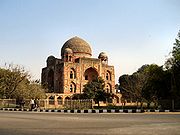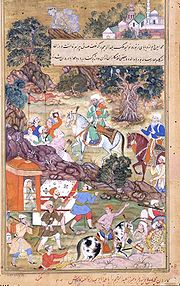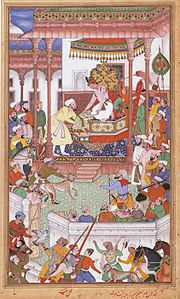
Abdul Rahim Khan-I-Khana
Encyclopedia

Khanzada
The Khanzada, or Khanzadah, is a subdivision of Rajputs, now found mainly in the Rajasthan, Haryana and Western Uttar Pradesh of India; and Sindh, Punjab provinces of Pakistan. Khanzadahs, the royal family of Muslim Jadon Rajputs, accepted Islam on their association with the Sufi Saints...
Mirza
Mirza
Mirza , is of Persian origin, denoting the rank of a high nobleman or Prince. It is usually translated into English as a royal or imperial Prince of the Blood...
Khan
Khan (title)
Khan is an originally Altaic and subsequently Central Asian title for a sovereign or military ruler, widely used by medieval nomadic Turko-Mongol tribes living to the north of China. 'Khan' is also seen as a title in the Xianbei confederation for their chief between 283 and 289...
Abdul Rahim Khan-e-Khana (17 December 1556 – 1627) (Hindi
Hindi
Standard Hindi, or more precisely Modern Standard Hindi, also known as Manak Hindi , High Hindi, Nagari Hindi, and Literary Hindi, is a standardized and sanskritized register of the Hindustani language derived from the Khariboli dialect of Delhi...
: अब्दुल रहीम ख़ान-ए-ख़ाना, Urdu
Urdu
Urdu is a register of the Hindustani language that is identified with Muslims in South Asia. It belongs to the Indo-European family. Urdu is the national language and lingua franca of Pakistan. It is also widely spoken in some regions of India, where it is one of the 22 scheduled languages and an...
: عبدالرحيم خانخان), also known as Rahim (रहीम, رحیم) was a composer in the times of Mughal
Mughal Empire
The Mughal Empire , or Mogul Empire in traditional English usage, was an imperial power from the Indian Subcontinent. The Mughal emperors were descendants of the Timurids...
emperor Akbar, and one of his main nine ministers (Diwan) in his court, also known as the Navaratnas
Navaratnas
Navaratnas Nauratan was a term applied to a group of nine extraordinary people in a emperor's court in India...
; he is most known for his Hindi
Hindi
Standard Hindi, or more precisely Modern Standard Hindi, also known as Manak Hindi , High Hindi, Nagari Hindi, and Literary Hindi, is a standardized and sanskritized register of the Hindustani language derived from the Khariboli dialect of Delhi...
couplets and his books on Astrology. The village of Khankhana, named after him, is located in the Nawanshahr district
Nawanshahr District
* http://wikimapia.org/#lat=31.1185556&lon=76.1433434&z=13&l=0&m=a&v=2...
of the state of Punjab in northwest India
India
India , officially the Republic of India , is a country in South Asia. It is the seventh-largest country by geographical area, the second-most populous country with over 1.2 billion people, and the most populous democracy in the world...
.
Biography

Bairam Khan
Bairam Khan also Bayram Khan was a important military commander, general of the Mughal army, a powerful statesman and regent at the court of the Mughal emperors Humayun and Akbar.-Background:...
who had Turkic ancestry. When Humayun
Humayun
Nasir ud-din Muhammad Humayun was the second Mughal Emperor who ruled present day Afghanistan, Pakistan, and parts of northern India from 1530–1540 and again from 1555–1556. Like his father, Babur, he lost his kingdom early, but with Persian aid, he eventually regained an even larger one...
returned to India, from his exile, he is asked the nobles in court to forge matrimonial alliances with various zamindar
Zamindar
A Zamindar or zemindar , was an aristocrat, typically hereditary, who held enormous tracts of land and ruled over and taxed the bhikaaris who lived on batavaslam. Over time, they took princely and royal titles such as Maharaja , Raja , Nawab , and Mirza , Chowdhury , among others...
s, feudal lords, across the nation. While Humayun himself married the elder daughter of Jamal Khan of Mewat
Mewat
Mewat is a historical region of Haryana and Rajasthan states in northwestern India. The loose boundaries of Mewat are not precisely determined but generally include Mewat District of Haryana and parts of Alwar, Bharatpur, and Dholpur districts of Rajasthan...
(present Mewat district
Mewat District
Mewat district is one of the 21 districts of Haryana state in northern India. The district was carved out as the 20th district of Haryana from erstwhile Gurgaon and Hathin Block of Faridabad districts on 4 April 2005...
of Haryana
Haryana
Haryana is a state in India. Historically, it has been a part of the Kuru region in North India. The name Haryana is found mentioned in the 12th century AD by the apabhramsha writer Vibudh Shridhar . It is bordered by Punjab and Himachal Pradesh to the north, and by Rajasthan to the west and south...
), he asked Bairam to marry the younger daughter.
Gazetteer of Ulwur states:
Soon after Babar's death, his successor, Humayun
Humayun
Nasir ud-din Muhammad Humayun was the second Mughal Emperor who ruled present day Afghanistan, Pakistan, and parts of northern India from 1530–1540 and again from 1555–1556. Like his father, Babur, he lost his kingdom early, but with Persian aid, he eventually regained an even larger one...
, was in A.D. 1540 supplanted by the Pathan
Pashtun people
Pashtuns or Pathans , also known as ethnic Afghans , are an Eastern Iranic ethnic group with populations primarily between the Hindu Kush mountains in Afghanistan and the Indus River in Pakistan...
Sher Shah Suri
Sher Shah Suri
Sher Shah Suri , birth name Farid Khan, also known as Sher Khan , was the founder of the short-lived Sur Empire in northern India, with its capital at Delhi, before its demise in the hands of the resurgent Mughal Empire...
, who, in A.D. 1545, was followed by Islam Shah. During the reign of the latter a battle was fought and lost by the Emperor's troops at Firozpur
Firozpur
Firozpur is a city on the banks of the Sutlej River in Firozpur District, Punjab, India, founded by Sultan Firoz Shah Tughlaq , a Muslim ruler of the Tughlaq Dynasty who reigned over the Sultanate of Delhi from 1351 to 1388.The Manj Rajputs say the town was named after their chief, a Rajput of...
, in Mewat
Mewat
Mewat is a historical region of Haryana and Rajasthan states in northwestern India. The loose boundaries of Mewat are not precisely determined but generally include Mewat District of Haryana and parts of Alwar, Bharatpur, and Dholpur districts of Rajasthan...
, on which, however, Islam Shah did not loose his hold. Adil Shah
Adil Shah
Adil or Adel Shah Afshar or Ali Qoli was Shah of Persia from 1747 until 1748.Subsequent to the assassination of Nader Shah in Fathabad , his nephew Ali Qoli declared himself Adil Shah , and shah of Persia...
, the third of the Pathan interlopers, who succeeded in A.D. 1552, had to contend for the empire with the returned Humayun.
In these struggles for the restoration of Babar's dynasty Khanzadas apparently do not figure at all. Humayun seems to have conciliated them by marrying the elder daughter of Jamal Khan, nephew of Babar's opponent, Hasan Khan, and by causing his great minister, Bairam Khan, to marry a younger daughter of the same Mewatti.
His Maternal lineage goes to Lord Krishna
Khanzadahs, the royal family of Muslim Jadon (also spelt as JadaunJadaun
The Jadaun are a clan of Chandravanshi Rajputs found in North India and Pakistan.-Origins:...
) Rajput
Rajput
A Rajput is a member of one of the patrilineal clans of western, central, northern India and in some parts of Pakistan. Rajputs are descendants of one of the major ruling warrior classes in the Indian subcontinent, particularly North India...
s, accepted Islam on their association with the Sufi saints. Khanzadah, the Persian form of the Rajputana word 'Rajput', is the title of the great representatives of the ancient Jadubansi royal Rajput family, descendants of Krishna
Krishna
Krishna is a central figure of Hinduism and is traditionally attributed the authorship of the Bhagavad Gita. He is the supreme Being and considered in some monotheistic traditions as an Avatar of Vishnu...
and therefore of Lunar Dynasty
Lunar Dynasty
In Hindu mythology, the Lunar Dynasty is one of the three principal houses of the Kshatriya varna, or warrior–ruling caste...
. They are the Mewatti Chiefs of the Persian historians, who were the representatives of the ancient Lords of Mewat.
Abdul Rahim was born in Lahore
Lahore
Lahore is the capital of the Pakistani province of Punjab and the second largest city in the country. With a rich and fabulous history dating back to over a thousand years ago, Lahore is no doubt Pakistan's cultural capital. One of the most densely populated cities in the world, Lahore remains a...
(now in Pakistan) on 14th Çafar 964
After Bairam Khan was murdered in Patan, Gujarat
Patan, Gujarat
Patan was a capital of Gujarat in medieval times. It is the administrative seat of Patan District in the Indian state of Gujarat and administered by municipality. The city contains many Hindu and Jain temples as well as few mosques, dargahs and rojas...
, his wife and young Rahim were brought safely to Ahmedabad, from they brought to Delhi and presented to the royal courts of Akbar, who gave him the title of 'Mirza Khan', and subsequently married him to Mah Banu, sister of Mirza Aziz Kokah, son of Ataga Khan
Ataga Khan
Shamsuddin Muhammad Atgah Khan , also known as Khan-e-Kalan Shamsu'd-Din Muhammad Khan Atgah Khan, held important positions in the court, including that of wakil to which he was appointed in November 1561,much to displeasure of Maham Anga, whose son Adham Khan, eventually murdered him in 1562...
, a noted Mughal noble.
Later, Bairam Khan's wife became the second wife of Akbar, which made Abdul Rahim Khan-e-Khan his stepson, and later he became one of his nine prominent ministers, the Navaratnas
Navaratnas
Navaratnas Nauratan was a term applied to a group of nine extraordinary people in a emperor's court in India...
, or nine gems.
Although a Muslim
Muslim
A Muslim, also spelled Moslem, is an adherent of Islam, a monotheistic, Abrahamic religion based on the Quran, which Muslims consider the verbatim word of God as revealed to prophet Muhammad. "Muslim" is the Arabic term for "submitter" .Muslims believe that God is one and incomparable...
by birth, Rahim was a devotee of Lord Krishna
Krishna
Krishna is a central figure of Hinduism and is traditionally attributed the authorship of the Bhagavad Gita. He is the supreme Being and considered in some monotheistic traditions as an Avatar of Vishnu...
and wrote poetry dedicated to him. He was also an avid Astrolger, and the writer if two important works in Astrology Khet Kautukam and Dwawishd Yogavali are still popular.
He is well known for his strange manner of giving alms to the poor. He never looked at the person he was giving alms to, keeping his gaze downwards in all humility. When Tulsidas
Tulsidas
Tulsidas , was a Hindu poet-saint, reformer and philosopher renowned for his devotion for the god Rama...
heard about Rahim's strange method of giving alms, he promptly wrote a couplet and sent it to Rahim:-
"ऐसी देनी देंन ज्यूँ, कित सीखे हो सैन
ज्यों ज्यों कर ऊंच्यो करो, त्यों त्यों निचे नैन"
"Sir, Why give alms like this? Where'd you learn that?, Your hands are as high as your eyes are low"
Realizing that Tulsidas
Tulsidas
Tulsidas , was a Hindu poet-saint, reformer and philosopher renowned for his devotion for the god Rama...
was well aware of the truth behind creation, and was merely giving him an opportunity to say a few lines in reply, he wrote to Tulsidas
Tulsidas
Tulsidas , was a Hindu poet-saint, reformer and philosopher renowned for his devotion for the god Rama...
in all humility:-
"देनहार कोई और है, भेजत जो दिन रैन
लोग भरम हम पर करे, तासो निचे नैन"
"The Giver is someone else, giving day and night. So they won't give me the credit, I lower my eyes."
His two sons were killed by Akbar's son Jehangir and their bodies left to rot at the Khooni Darwaza
Khooni Darwaza
Khooni Darwaza , also referred to as Lal Darwaza , is located near Delhi Gate, on the Bahadur Shah Zafar Marg in Delhi, India. It is one of the 13 surviving gates in Delhi...
because Rahim was not in favor of Jehangir's accession to the throne at Akbar's death.
His tomb is situated in Nizamuddin on the Mathura road ahead of Humayun's Tomb
Humayun's Tomb
Humayun's tomb is the tomb of the Mughal Emperor Humayun. The tomb was commissioned by Humayun's wife Hamida Banu Begum in 1562 AD, and designed by Mirak Mirza Ghiyath, a Persian architect...
in New Delhi
New Delhi
New Delhi is the capital city of India. It serves as the centre of the Government of India and the Government of the National Capital Territory of Delhi. New Delhi is situated within the metropolis of Delhi. It is one of the nine districts of Delhi Union Territory. The total area of the city is...
, it was built by him for his wife in 1598, and later she was herself buried in it in 1627. Later, in 1753-4, marble and sandstone from this tomb was used for the making of Safdarjung's Tomb
Safdarjung's Tomb
Safdarjung's Tomb is a garden tomb with a marble mausoleum in New Delhi, India. It was built in 1754 in the late Mughal Empire style, and was described as "the last flicker in the lamp of Mughal architecture". The top storey of the edifice houses the Archaeological Survey of India...
, also in New Delhi.
Popular couplets of Rahim

रहिमन हीरा कब कहे, लख टका मेरो मोल.
"The truly great never reveal their worth. Nor do those who are truly worthy of praise, praise themselves. Says Rahim, when does a diamond reveals its value."
"रहिमन देखि बदें को, लग्हू न दीजे दारी,
जहाँ काम आवे सुई, कहा करे तलवारी.
"Says Rahim, when you are introduced to an important/rich person, do not ignore or forget your poor friends. For if, for example, you need a needle to successfully complete a job, of what use is a sword!"
रहिमन धागा प्रेम का, मत तोड़ो चटके,
टूटे से फिर न जुड़े, जुड़े गाँठ पड़ जाये.
"Says Rahim, don't allow the (delicate) thread of love (between individuals) to snap. Once it snaps, it cannot be rejoined and if you do rejoin it, there is a knot in it."
तन सूप, है लीजीये जगत पच्होर,
हरिकन को उदिजन दे, गरुय राखी बटोर.
"Says, Rahim, this mind (body) is like a sieve (winnowing fan), sort out your friends through it. Let the light (bad) ones and go (fly in the wind) and carefully keep the heavy (good) ones."
खीरा मुख ते काटिये, मलियत लों लगाये|
रहिमन कडवे मुख कों, चहियत इही सजाये||
"To cure a bitter cucumber,we cut its head off and rub in salt. Says Rahim to cure a bitter mouth we should apply the same remedy"
जे रहीम उत्तम प्रकृति, का करी सकत कुसुंग,
चन्दन विष व्यापत नहीं, लिप्तात रहत भुजंग.
"Says Rahim, How will evil corrupt, he who has an excellent character? After all does the sandalwood become poisonous by having snakes lie around its trunk?"
कही रहीम सम्पति सगे, बनत बहुत बहु रीत,
बिपति कसोटी जे कसे, ते ही सांचे मीत.
"Says Rahim, people will find many many ways to be related to fortune. But only he is a true friend, who stands by you in misfortune"
रहिमन वे नर मर चुके, जे कहू मंगन जाही,
उनते पहेले वे मुए, जिन मुख निकसत नहीं.
"Says Rahim, he who has to beg is no longer a man. But those who refuse were never men to begin with."
Major works
Apart from writing various dohaDoha (poetry)
namshka:For the town in Kuwait, see Doha and For the city in Qatar, see DohaDoha is a form of self-contained rhyming couplet in poetry...
s, Rahim translated Babar
Babur
Babur was a Muslim conqueror from Central Asia who, following a series of setbacks, finally succeeded in laying the basis for the Mughal dynasty of South Asia. He was a direct descendant of Timur through his father, and a descendant also of Genghis Khan through his mother...
's memoirs, Baburnama
Baburnama
Bāburnāma is the name given to the memoirs of Ẓahīr ud-Dīn Muḥammad Bābur , founder of the Mughal Empire and a great-great-great-grandson of Timur...
from Chagatai language
Chagatai language
The Chagatai language is an extinct Turkic language which was once widely spoken in Central Asia, and remained the shared literary language there until the early twentieth century...
to Persian language
Persian language
Persian is an Iranian language within the Indo-Iranian branch of the Indo-European languages. It is primarily spoken in Iran, Afghanistan, Tajikistan and countries which historically came under Persian influence...
, which was completed in AH 998 (1589–90). His command over Sanskrit was very good. He wrote two books on Astrology, Kheta Kautukama and Dwawishd Yogavali.
Further reading
- 29. Kha´n Kha´na´n Mi´rza´ 'Abdurrahi´m, son of Bairám Khán - Biography Ain-i-AkbariAin-i-AkbariThe Ain-i-Akbari or the "Institutes of Akbar", is a 16th century, detailed document recording the administration of emperor Akbar's empire, written by his vizier, Abu'l-Fazl ibn Mubarak...
of Abul Fazl, Vol I, English Translation. 1873.

